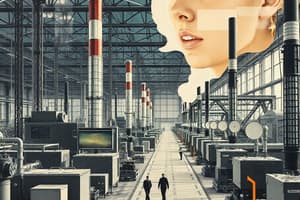Podcast
Questions and Answers
Which of the following best describes how smart factories leverage data to improve operations?
Which of the following best describes how smart factories leverage data to improve operations?
- They gather data to monitor employee performance and productivity.
- They use data analytics to optimize processes and make informed decisions. (correct)
- They use data collected from social media to predict consumer trends.
- They rely on historical sales data to forecast future revenue.
What role do cyber-physical systems (CPS) play in the context of Industry 4.0 and smart factories?
What role do cyber-physical systems (CPS) play in the context of Industry 4.0 and smart factories?
- CPS primarily handle the financial transactions and accounting of the factory.
- CPS integrate physical machinery with computational capabilities for data collection, monitoring, and autonomous decision-making. (correct)
- CPS are mainly responsible for managing human resources and employee training within the factory.
- CPS act as the communication interface between customers and the factory's sales department.
In the context of smart cities, how does citizen engagement primarily contribute to urban development?
In the context of smart cities, how does citizen engagement primarily contribute to urban development?
- By providing funding for new construction projects.
- Through interactive platforms and mobile apps that promote public participation in urban planning and governance. (correct)
- By ensuring that all citizens have access to high-speed internet.
- By increasing the number of tourists visiting the city.
How does advanced automation contribute to enhanced safety in smart factories?
How does advanced automation contribute to enhanced safety in smart factories?
Which of the following examples demonstrates the application of sustainable practices in smart cities?
Which of the following examples demonstrates the application of sustainable practices in smart cities?
How do cyber-physical systems contribute to preventive maintenance in industrial settings?
How do cyber-physical systems contribute to preventive maintenance in industrial settings?
Why is flexibility and agility considered a key principle of smart factories?
Why is flexibility and agility considered a key principle of smart factories?
Which component of a Cyber-Physical System (CPS) is responsible for effecting change in the physical environment based on data analysis?
Which component of a Cyber-Physical System (CPS) is responsible for effecting change in the physical environment based on data analysis?
What is the primary role of ICT (Information and Communication Technology) infrastructure in a Smart City?
What is the primary role of ICT (Information and Communication Technology) infrastructure in a Smart City?
Data-driven insights are used in smart factories to improve innovation. How is this accomplished?
Data-driven insights are used in smart factories to improve innovation. How is this accomplished?
Flashcards
Smart Factory
Smart Factory
An interconnected production system using technologies like CPS, AI, and IoT to create an autonomous and intelligent manufacturing environment.
Interconnectivity
Interconnectivity
Real-time communication between machines and sensors in a Smart Factory.
Data-Driven Decision Making
Data-Driven Decision Making
Using analytics to optimize operations in a Smart Factory.
Cyber-Physical Integration
Cyber-Physical Integration
Signup and view all the flashcards
Cyber-Physical Systems (CPS)
Cyber-Physical Systems (CPS)
Signup and view all the flashcards
Physical Components
Physical Components
Signup and view all the flashcards
Computational Components
Computational Components
Signup and view all the flashcards
Smart City
Smart City
Signup and view all the flashcards
ICT Infrastructure
ICT Infrastructure
Signup and view all the flashcards
Data Analytics (Smart City)
Data Analytics (Smart City)
Signup and view all the flashcards
Study Notes
- The focus of the text is the summary of Smart Factories, Cyber-Physical Systems (CPS), and Smart Cities.
Smart Factories
- Smart Factories form interconnected production systems using Cyber-Physical Systems (CPS), Artificial Intelligence (AI), and the Internet of Things (IoT).
- This creates autonomous and intelligent manufacturing environments.
Key Principles of Smart Factories
- Interconnectivity enables machines and sensors to communicate in real-time.
- Data-Driven Decision Making uses analytics to optimize operations.
- Cyber-Physical Integration merges digital and physical systems.
- Advanced Automation uses robots to perform tasks and to collaborate with humans.
- Flexibility and Agility enables quick adaptation to market demands.
- Sustainability reduces waste and optimizes resources.
Advantages of Smart Factories
- Increased productivity and efficiency
- Improved quality control
- Enhanced safety through automation
- Cost reductions via predictive maintenance.
- Greater innovation through data-driven insights.
Real-World Examples of Smart Factories
- Tesla Gigafactory (Germany) uses AI-driven electric vehicle production.
- Alibaba (China) utilizes IoT and AI for agile fashion manufacturing.
- Saudi Aramco (Saudi Arabia) uses sensors and AI for oil monitoring.
Cyber-Physical Systems (CPS)
- CPS integrates physical machinery with computational capabilities.
- Collection of data, it monitors performance, facilitates communication, and enables autonomous decisions.
Main Components of CPS
- Physical Components include sensors, actuators, and robots.
- Computational Components consist of microcontrollers, software, and data processing.
- Network Connectivity ensures real-time communication between systems.
Advantages of CPS
- Real-time monitoring for preventive maintenance.
- Data-driven decision-making.
- Autonomous control for efficient operations.
- Enhanced human-machine collaboration.
Smart Cities
- Smart Cities leverage IoT, AI, and big data to optimize urban services, infrastructure, and sustainability.
Main Components of Smart Cities
- ICT Infrastructure uses high-speed internet, cloud computing, and sensors.
- Data Analytics analyzes urban data for better decision-making.
- Citizen Engagement uses interactive platforms and mobile apps for public participation.
- Sustainable Practices optimize energy use and green transportation.
Smart City Initiatives in the UAE
- Dubai's "Dubai 10X" vision includes smart meters, AI-driven energy optimization, and smart traffic systems.
- Abu Dhabi includes Masdar City (sustainable urban development) and the Integrated Transport Centre (smart public transport management).
- Utilizing these technologies shapes the future of manufacturing and urban development, enhancing efficiency, sustainability, and innovation.
Studying That Suits You
Use AI to generate personalized quizzes and flashcards to suit your learning preferences.




